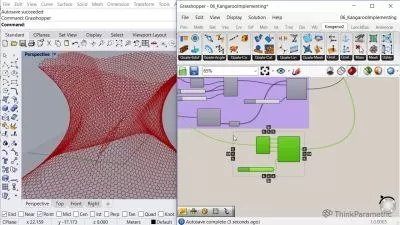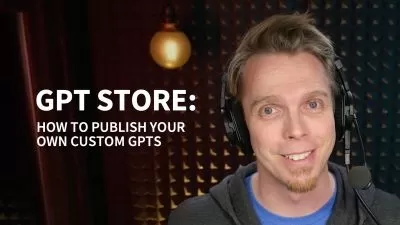OpenAI, GPT, ChatGPT and DALL-E Masterclass
Raymond Davey
4:22:08
Description
Everything from No-Code, through to fine-tuning & embedding with code examples in multiple programming languages.
What You'll Learn?
- No-Code examples using OpenAI playground
- Techniques to create, expand, rewrite, and summarize text for creative writing, articles and blogs using GPT
- In depth Prompt Engineering with examples and Tips/Tricks
- Understand what every fine tuning parameter does with recommended values
- How to write code to call GPT and OpenAI using several different programming languages
- How to generate, document, and explain code and SQL in plain english using CODEX
- Deep dive into creating and uploading Fine Tuning sets to train GPT with your own data
- How to use Embedding to search large documents and ask questions related to its content
- How to use Embedding for Clustering and Classification to find hidden patterns
- Create and modify images using DALL-E
- Write your own chatbot using GPT
- Best Safety Practices and Cost Saving Tips
Who is this for?
More details
DescriptionRequirements
Beginner and Intermediate level: None
Advanced level content: Programming skills in any language
Description
Welcome to the Masterclass for GPT, DALL-E and ChatGPT.
Ever since OpenAI arrived on the scene, access to a trained AI has become accessible to everyone.
GPT allows you to ask a chatbot to complete tasks, and to answer questions
Fine-tuning allows you to change the way the AI responds
Embedding allows you to use your own knowledge base
Dall-E allows you to generate images from text
In this course, you will learn very practical skills for using GPT. The skills can be used in the OpenAI playground or in programming code.
The course is split into 6 major parts:
Introduction and Prompt Engineering
Writing code and calling the API
Dall-E and Codex
Fine-tuning
Embedding
Writing and managing Chatbots
PART 1: Introduction and Prompt Engineering
In this section, you will learn how to get started with GPT. We also explain, design and use different types of prompts. At the end of the prompt engineering section, we give you two recipes you can use to get consistent results.
We'll see how GPT works, including:
what tokens are
high level overviews of GPT, Codex and Dall-E
live examples of using the playground
ways to improve prompts to get better results
how to use templating to create reliable prompts
how to use context to introduce new knowledge
This is already very practical.
We cover everything from "zero-shot" queries, through to multi-shot and advanced template prompts.
An entire section of the course is dedicated to creative writing for blogs, books and articles.
PART 2: Writing Code to use the API
In this section, you will learn how to write code to call GPT and the OpenAIÂ API. Most of the examples are written in Python, but they are equally usable in C#, Typescript, Javascript, Node.js, PHP, Powershell and many other languages.
There are examples and explanations of how to adapt the code for each of these languages. We introduce various coding libraries and point out issues that may be specific to each language.
Once you start writing code, we go into all of the possible parameters and how they can change the way GPTÂ works. We explain what they do, and ideal values for different situations.
As well as covering the completions endpoint, we also talk about the edit or instruction end point.
PART 3: CodeX and Dall-E
In this section, you will learn how you can use CodeX to generate, debug, and document code. We also give an example of how you can use CodeX to create unit tests for your functions.
You will find out how you can tell CodeX about new API calls and functions that are not part of its standard learning. We also use the edit endpoint to create an entire function from scratch.
Because CodeX generates code, we discuss the safety of using the code it generates and highlight several serious issues that you need to consider if you intend to use the code in production. We point out possible vulnerabilities and ways hackers can exploit the code it generates.
When it comes to Dall-E we walk through practical code examples to creating or edit images. We provide examples in multiple programming languages and explain how to handle images in memory and on your file system
PART 4: Fine Tuning
In this section we explain how you can fine-tune GPT. We explain the benefits and the difficulties. There are plenty of training examples and strategies you can use. We walk you through creating a set from scratch and uploading it OpenAI using your own code.
This followed by an entire section explaining how you can use GPT to create its own trainings sets and how to get GPT to check and improve its own outputs.
To round out this section of the course, we go though all of the fine-tuning parameters. We explain how you can change settings to adjust the impact the rules have on the base training.
Part 5: Training on Large Text Documents using Embedding
Everyone wants to know how you can train GPTÂ on large text documents. This section of the course explains how to take a text document and use it to answer questions using GPT. Embedding vectors are explained in great detail. We also explain the theory behind them so you know what GPT is doing. We talk about breaking up large text documents, creating embeddings, and searching the results.
We also talk about creating highly accurate classifiers and using clustering to find hidden patterns within documents and text.
Part 6: Chatbots
Who doesn't want their own chatbot? We explain how you can use GPT as a fully functional chatbot. We explain about personas and give you a recipe you can use to give your chatbot a personality and keep it on track.
To keep your chatbot on task and to give it persistent memory, we explain how you can use embedding to enhance the functionality and provide unique knowledge that is not part of the base GPT training.
UNIQUE FEATURES
Every line of code explained in detail - email me any time if you disagree
No wasted time "typing" on the keyboard like other courses. Instead we show finished code examples and prompts with detailed explanations that you can apply to your own use cases.
Thank you for reading and I hope to see you soon!
Who this course is for:
Anyone who wants to master GPT and OpenAI
Anyone who loves deep Natural Language Processing
Anyone who wants to create their own chatbots or products using OpenAI and GPT
Who this course is for:
- Anyone interested in utilizing OpenAI and GPT for artificial intelligence
Requirements
Beginner and Intermediate level: None
Advanced level content: Programming skills in any language
Description
Welcome to the Masterclass for GPT, DALL-E and ChatGPT.
Ever since OpenAI arrived on the scene, access to a trained AI has become accessible to everyone.
GPT allows you to ask a chatbot to complete tasks, and to answer questions
Fine-tuning allows you to change the way the AI responds
Embedding allows you to use your own knowledge base
Dall-E allows you to generate images from text
In this course, you will learn very practical skills for using GPT. The skills can be used in the OpenAI playground or in programming code.
The course is split into 6 major parts:
Introduction and Prompt Engineering
Writing code and calling the API
Dall-E and Codex
Fine-tuning
Embedding
Writing and managing Chatbots
PART 1: Introduction and Prompt Engineering
In this section, you will learn how to get started with GPT. We also explain, design and use different types of prompts. At the end of the prompt engineering section, we give you two recipes you can use to get consistent results.
We'll see how GPT works, including:
what tokens are
high level overviews of GPT, Codex and Dall-E
live examples of using the playground
ways to improve prompts to get better results
how to use templating to create reliable prompts
how to use context to introduce new knowledge
This is already very practical.
We cover everything from "zero-shot" queries, through to multi-shot and advanced template prompts.
An entire section of the course is dedicated to creative writing for blogs, books and articles.
PART 2: Writing Code to use the API
In this section, you will learn how to write code to call GPT and the OpenAIÂ API. Most of the examples are written in Python, but they are equally usable in C#, Typescript, Javascript, Node.js, PHP, Powershell and many other languages.
There are examples and explanations of how to adapt the code for each of these languages. We introduce various coding libraries and point out issues that may be specific to each language.
Once you start writing code, we go into all of the possible parameters and how they can change the way GPTÂ works. We explain what they do, and ideal values for different situations.
As well as covering the completions endpoint, we also talk about the edit or instruction end point.
PART 3: CodeX and Dall-E
In this section, you will learn how you can use CodeX to generate, debug, and document code. We also give an example of how you can use CodeX to create unit tests for your functions.
You will find out how you can tell CodeX about new API calls and functions that are not part of its standard learning. We also use the edit endpoint to create an entire function from scratch.
Because CodeX generates code, we discuss the safety of using the code it generates and highlight several serious issues that you need to consider if you intend to use the code in production. We point out possible vulnerabilities and ways hackers can exploit the code it generates.
When it comes to Dall-E we walk through practical code examples to creating or edit images. We provide examples in multiple programming languages and explain how to handle images in memory and on your file system
PART 4: Fine Tuning
In this section we explain how you can fine-tune GPT. We explain the benefits and the difficulties. There are plenty of training examples and strategies you can use. We walk you through creating a set from scratch and uploading it OpenAI using your own code.
This followed by an entire section explaining how you can use GPT to create its own trainings sets and how to get GPT to check and improve its own outputs.
To round out this section of the course, we go though all of the fine-tuning parameters. We explain how you can change settings to adjust the impact the rules have on the base training.
Part 5: Training on Large Text Documents using Embedding
Everyone wants to know how you can train GPTÂ on large text documents. This section of the course explains how to take a text document and use it to answer questions using GPT. Embedding vectors are explained in great detail. We also explain the theory behind them so you know what GPT is doing. We talk about breaking up large text documents, creating embeddings, and searching the results.
We also talk about creating highly accurate classifiers and using clustering to find hidden patterns within documents and text.
Part 6: Chatbots
Who doesn't want their own chatbot? We explain how you can use GPT as a fully functional chatbot. We explain about personas and give you a recipe you can use to give your chatbot a personality and keep it on track.
To keep your chatbot on task and to give it persistent memory, we explain how you can use embedding to enhance the functionality and provide unique knowledge that is not part of the base GPT training.
UNIQUE FEATURES
Every line of code explained in detail - email me any time if you disagree
No wasted time "typing" on the keyboard like other courses. Instead we show finished code examples and prompts with detailed explanations that you can apply to your own use cases.
Thank you for reading and I hope to see you soon!
Who this course is for:
Anyone who wants to master GPT and OpenAI
Anyone who loves deep Natural Language Processing
Anyone who wants to create their own chatbots or products using OpenAI and GPT
Who this course is for:
- Anyone interested in utilizing OpenAI and GPT for artificial intelligence
User Reviews
Rating
Raymond Davey
Instructor's Courses
Udemy
View courses Udemy- language english
- Training sessions 109
- duration 4:22:08
- Release Date 2023/03/02




















